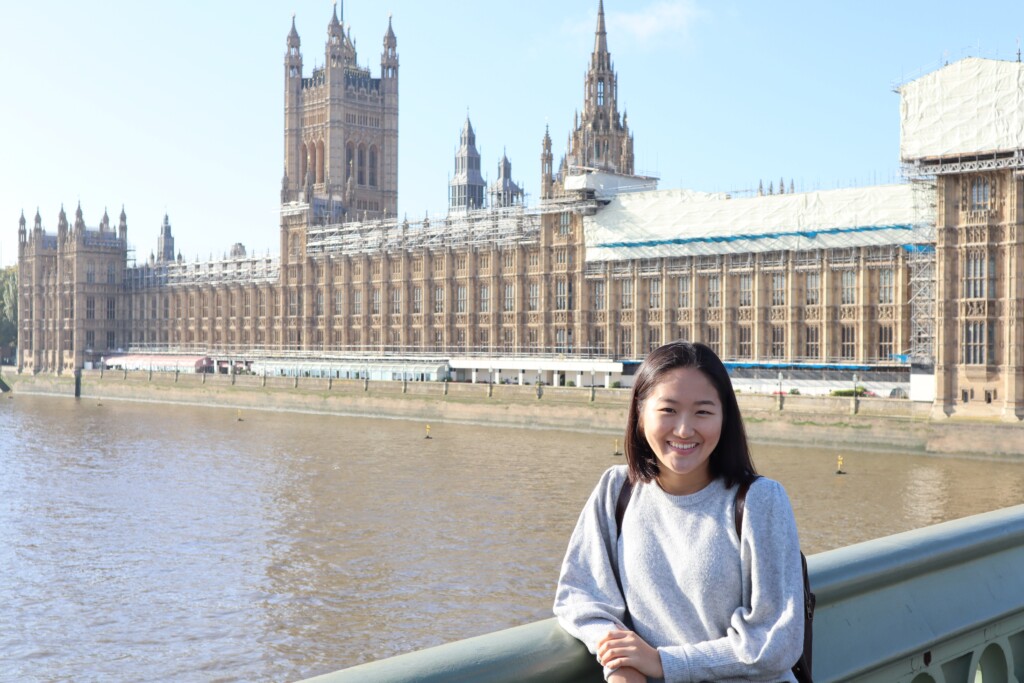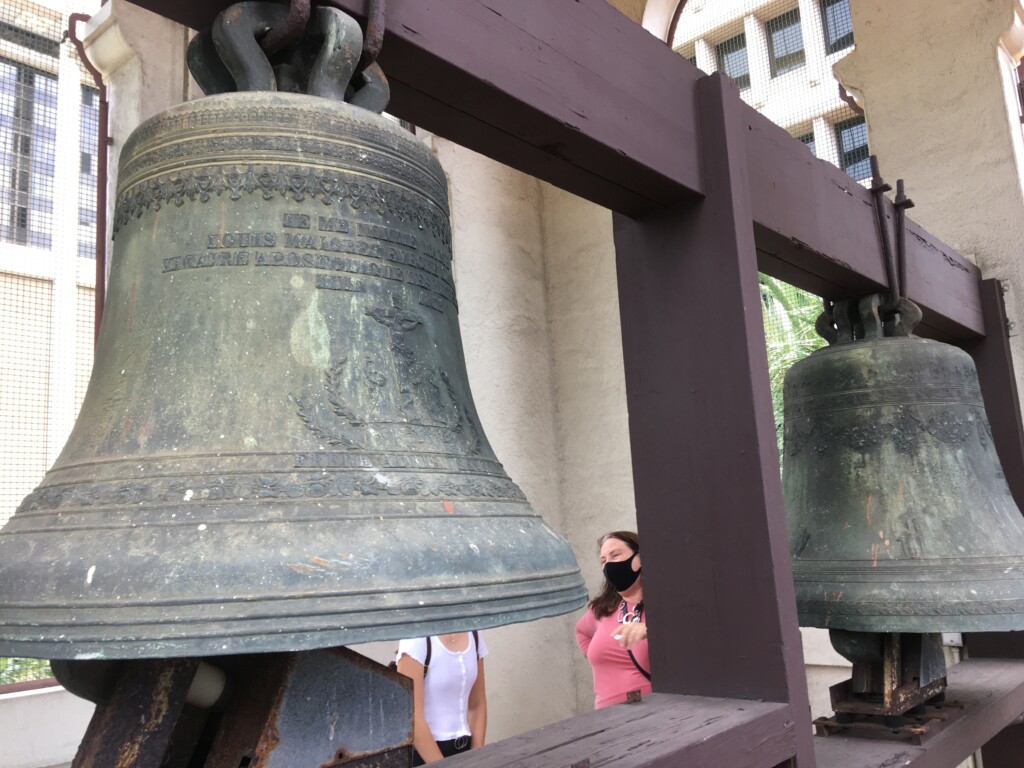A Self-Directed Independent Study Project with HHF
By Nayun Hong, student of architecture at University of Notre Dame, September 8, 2020

Nayun in London during her study abroad.
This summer, I had the opportunity to pursue a self-directed independent study project with Historic Hawai’i Foundation (HHF). I had just completed my junior year in architecture school at the University of Notre Dame, which was supposed to be a full year abroad in Rome, Italy, until I was unfortunately sent home due to the pandemic. Before this abrupt ending, my seven months next to the Colosseum was truly a once-in-a-lifetime experience living in a city with so many layers of architectural and cultural history. I learned so much, both inside and outside the classroom, and was looking forward to applying all that I learned at a firm through a summer internship. Unfortunately, the state of our public health only worsened since my repatriation from Rome and many of the emails I sent to firms were ignored or received with apologetic responses.
Although I struggled difficult to stay positive at times, I was determined to pursue some type of summer experience where I could enrich my knowledge in architecture or a field closely related to it.
After a Google search of “historic preservation in Hawai’i”, I came across Historic Hawai‘i Foundation’s website and, with very low expectations, sent an email to Andrea Nandoskar, the Education Program Manager. As an aspiring architect, I understand that there is so much more to architectural practice than design and construction. As a student of a classical and traditional architecture program, I understand the importance of preserving the character of places, and that is not possible without historic preservation.
Although it wasn’t the design internship I planned for, my experience with HHF allowed me to learn more about a field within the broad study of architecture, especially about topics that aren’t really taught to architecture students in school. I gained a greater understanding of architecture from a different perspective, a perspective that I am excited to bring back to my peers at Notre Dame.
The independent study consisted of three main components: an introduction to historic preservation in the United States–its history, methods and techniques, and how it impacts us today–discussions with different professionals in the field of historic preservation, and an independent research and deliverable project focusing on a specific historic building in Hawai’i. The initial study on the background of historic preservation allowed me to learn more about American and Hawaiian architecture, as well as architectural history in the context of general U.S. history. Such topics are barely touched upon in school, so I felt that it was important to take the time to learn more about these things on my own. During this part of the study, I was surprised to learn just how interconnected historic preservation is with so many other disciplines in the field of architecture, such as urbanism and sustainability.
Because of this independent study, I am now more interested in seeing how this connectivity between the three fields can support one another. How can we argue for sustainable design and cities through new urbanism and preservation? How can we argue for historic preservation as it relates to sustainability and urban planning?
The second component consisted of talk stories with a variety of professionals in the field including architecture, landscape architecture, architectural history, archaeology, history, and planning. For me, this was the most valuable part of this experience. The depth and breadth of the conversations I was able to engage in allowed me to learn about historic preservation beyond definitions and through more personal stories and interactions.
I met so many passionate individuals from different professions and industries who contribute to the work of historic preservation, which goes to show what an interdisciplinary field it is.
This component of the study was something that only HHF could have provided and I am so thankful that they organized these discussions for me to participate in such meaningful conversations that I wouldn’t have been able to otherwise.
An overlapping theme from all four talk stories was the value of community. This emphasis on community engagement made a lot of sense, but I found it interesting how frequently it was brought up during four separate conversations. As an architecture student, this is how I understood the role of the community in a preservationist’s work. When architects design, they don’t do it for themselves. They do it for their clients, who will actually experience and benefit from their designs. The same applies to preservation. When historic preservationists preserve, they don’t do it for themselves, but for the community whose history lies within these architectural artifacts.
The professionals I spoke to all had a similar idea in mind: they do the work that they do because they want to preserve the community. They make it a priority to maintain communication with the community, especially during projects that concern them, to continue to educate them. They have a sense of humility when dealing with the community, for they understand that the local organizations have valuable insights to contribute from a more personalized and intimate perspective. They strive to be an advocate for the community through their work and actions. These professionals take pride in the fact that their work in preservation is not only for the sake of preserving tangible artifacts, but also for the sake of the stories that are attached to those artifacts.
The most impactful and valuable experiences and lessons learned are often the most challenging and that’s how I felt about the talk stories. When I first heard about the structure of these talk stories from Andrea, I was definitely intimidated. I am not the best speaker and would describe myself as very soft-spoken. I am more of a listener than a speaker, so even asking questions in class is very difficult for me. However, I realized that these talk stories and the depth of our conversations relied heavily on my ability to ask questions. It posed a huge personal challenge but with each talk story, I found myself becoming more comfortable engaging in the discussions.
Another reason I was so intimidated was because the idea of interacting with such accomplished and knowledgeable individuals was terrifying. As a student, I know so little compared to all that they know. What if I say the wrong thing? What if I ask the wrong questions? Eventually Andrea helped me realize that at some point in their lives, they were also a student like me. They didn’t start out knowing everything. They are who they are now because of years of experience and education. As scary as experiences like the talk stories are, it’s experiences like these that will (hopefully) shape me into someone who is just as accomplished and knowledgeable. I am thankful to the professionals for being so kind and understanding, for they really made the talk stories an inspiring and a humbling experience.
Additionally, these talk stories allowed me to network with people in the field of historic preservation. Following the first talk story, Barbara Shideler, a preservation architect with MASON reached out to coordinate an office visit. One of the main reasons why I wanted to pursue an architecture internship this summer was to experience working at a firm and to connect with different professionals in my field. I was very disappointed to be missing out on this experience but the talk stories, especially the visit to MASON, made up for a lot of it. I received a tour of the office, tagged along on a site visit to Cathedral Basilica of Our Lady of Peace, and connected with other employees at MASON. I maintained contact with Ann Yoklavich, an architectural historian with MASON, who became a point of reference and resource for my independent research portion of the project. She also took me on a personal walking tour around downtown Honolulu and the Capital district. Prior to the talk story and my visit to their office, I wasn’t too familiar with MASON but I’m so glad I had the opportunity to learn more about them and their work in historic preservation, as well as the opportunity to connect with other professionals in my field of interest.

Visiting the Bell Tower at Our Lady of Peace Cathedral. Photo by Ann Yoklavich, MASON.
On a more personal note, this experience helped me come to terms with discomfort and uncertainty. I am a 22-year old senior in college (fortunately with one more year left in my program), four years deep in my major, but I am still unsure whether this is what I want to do for the rest of my life. I know that I love architecture and urbanism, but I am not sure if I want to pursue a career in design. This independent study on historic preservation made me realize that: 1) this might be something that I would rather do instead; 2) it’s good to let myself try new things, even if they scare me and aren’t on the path I initially intended to walk on, for they might reveal something that I didn’t know about myself; and 3) it’s okay to be unsure, to not know everything yet. I am only 22 and there is so much I have yet to learn and experience, and the study of historic preservation was one of those things. Had I not taken the chance to reach out to Andrea this May, I think I would still be in an uncomfortable place–uncomfortable with the (incorrect) idea that I have only one career path ahead of me, uncomfortable with not knowing what the future holds, and uncomfortable with being uncomfortable!
I am so thankful to Andrea, Kiersten Faulkner (HHF’s executive director), Virginia Murison (HHF’s consulting preservation architect) and the rest of HHF’s staff along with MASON, and everyone else who participated in the talk stories for making this summer such an enriching experience. My independent study exceeded all of my expectations and I really hope that this initiative will continue for years to come so that students like me–both in high school and college–can learn more about historic preservation, the work involved in the field, and how it affects our community today. It was only a month long, but I learned so much about historic preservation and myself. It was such a comprehensive and immersive experience with pandemic restrictions, so I’m excited to see how great of a program this will be post COVID!
Historic Hawaii Foundation thanks all of the professionals who helped provide Nayun with this invaluable experience.

